

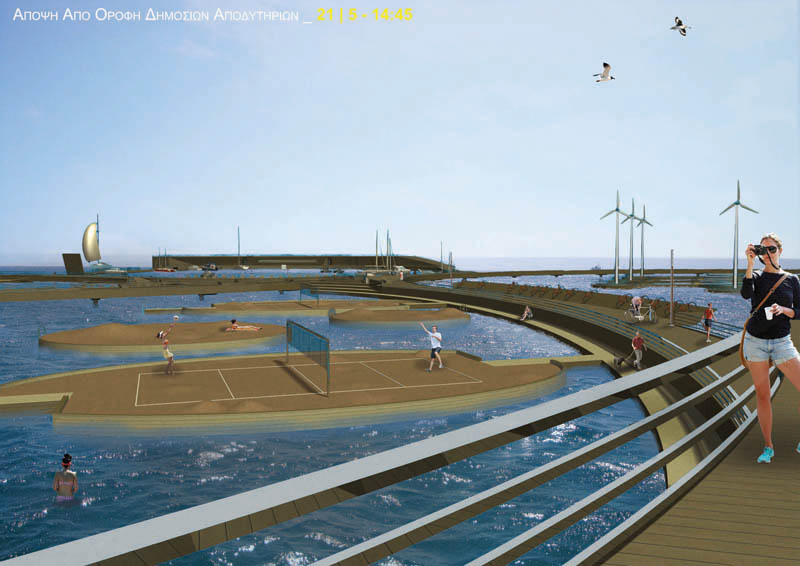



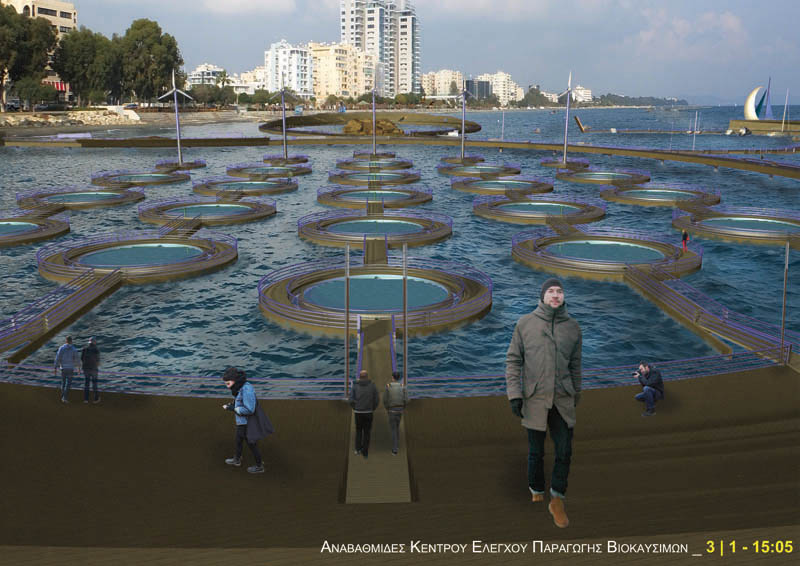

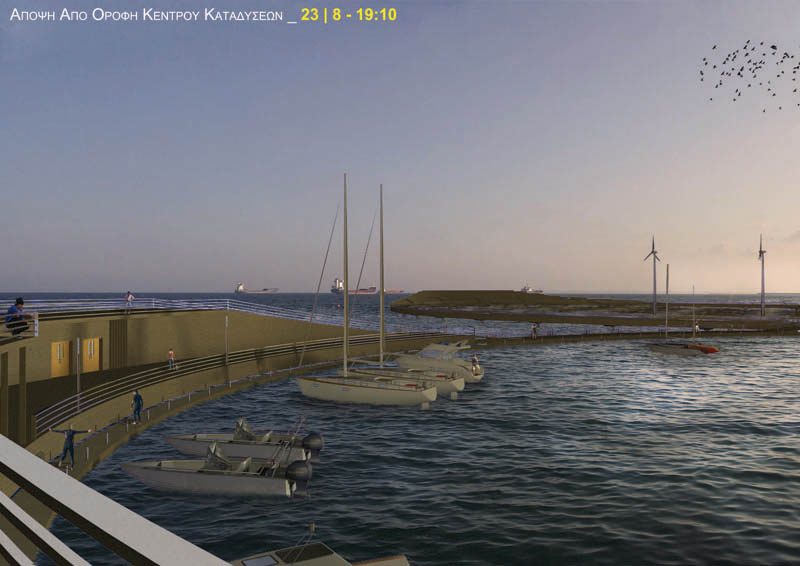

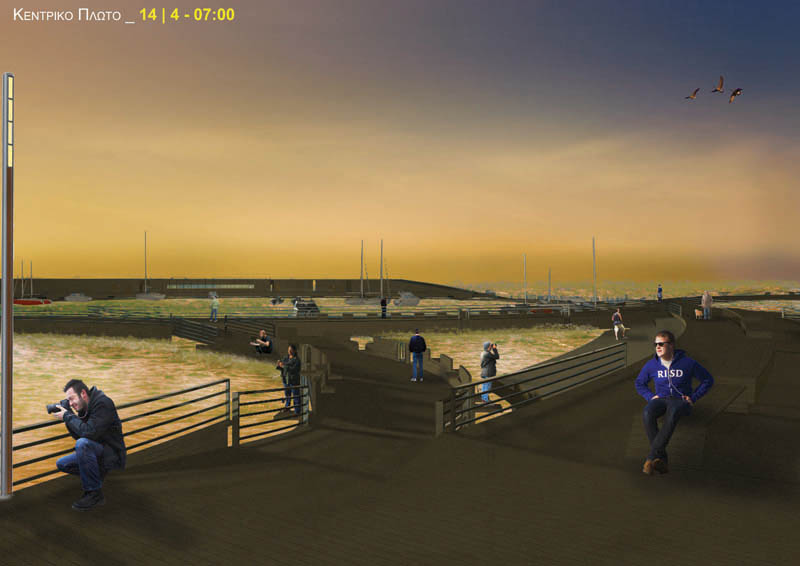

The subject of this thesis is the design of a platform that accommodates mainly leisure and recreation activities related to water, in “Enaerios”, a waterfront area in Limassol.
Through this construction it is sought a redefinition of the relationship between the sea and the cityscape of Limassol, which is being altered year after year.
Raising the coastline limits of the city and boosting the already existing activities in the area, this structure is meant to decongest the eastern coastal front of the city and convert the region into an activity center.
The area of Enaerios, for about eighty-five years (1904 -1988), was a point of reference for the residents and had great commercial and economic significance for the whole country of Cyprus. There by means of aerial railroad, sacks with asbestos from the asbestos mine located in the Village of Pano Amiantos, were delivered and stored until the time of export. Today, except from the pier that is preserved, nothing else reminds this area’s old image, but it still remains one of the most important areas of the city. It provides high density of visitors all year round and this is because it still combines activities of different nature, such as labour, trade, as well as activities of leisure and recreation.
Among other, activities of the same type are included in the platform and the need for their right combination, without one activity to negate the other, was set the basic form of the structure, which consists of constant and floating parts.
In general, the mild climate of the city of Limassol, and the warm waters of the Mediterranean Sea, allow all year-round use of the platform, thus serving the users of the area, and the wider part of the city. At the same time , during the seasonal variations that affect the sea level, the floating parts of the construction are adjusted accordingly creating a different image every time, image that interacts with the city.
In addition to the use of the construction for leisure and entertainment, an energy production park of algae biomass will be integrated in the platform, open to the public, thereby connecting indirectly the area with its industrial past. The relationship of organisms like algae with the liquid element, and the growing interest shown in recent years for their contribution to the energy design are the reasons why they were selected to be included in the construction.
Finally, in the context of environmental design, in the construction there is a provision to deal with intense sunlight and the prevailing winds. Some elements of urban furniture are also customizable according to the seasons and the needs of area’s users.
Supervisor: Trova Vasso
Reference Number: 480
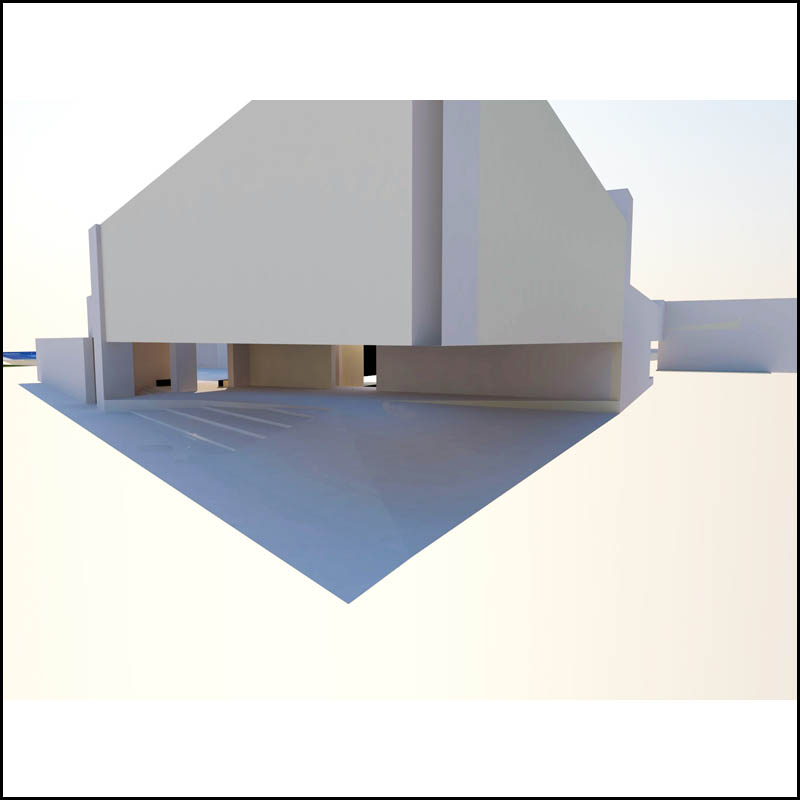





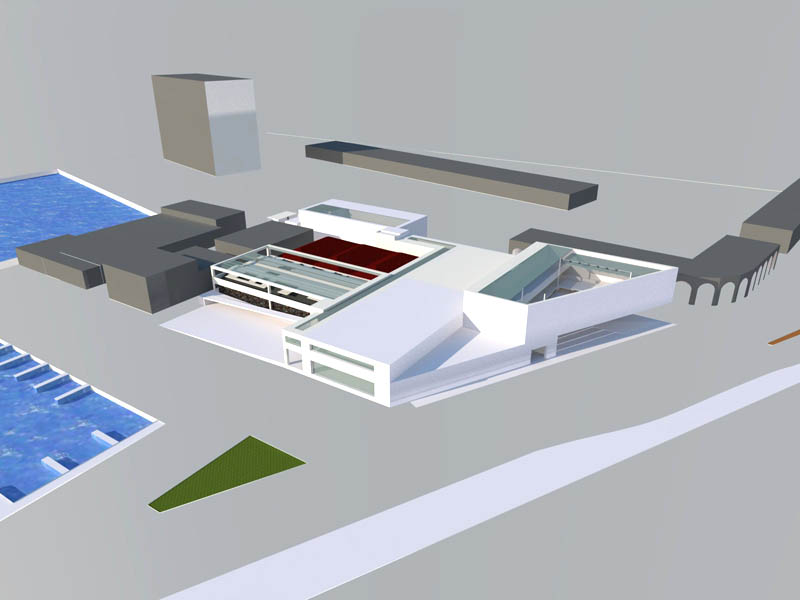

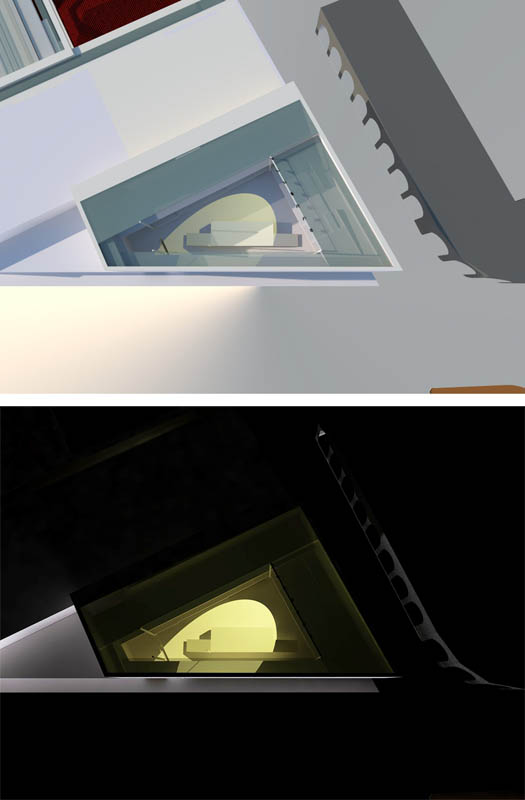



The topic of the thesis project is based on the codification of a general system of constructions that have to do with any form of art , which is inserted into the city. Through the construction of a multiplex at the area of Palaia, next to the waterfront , which includes workshops , projection halls and auditoriums , living rooms and teaching halls , there comes a suggestion of several ways of penetration and connection of the existing buildings with new particles. The ways in which this can be achieved can be either adding new volumes that comprise older ( intercalary in basic points ) , by removing some non-structural elements , the empty space of which is able to define aesthetically interesting and practical spaces , or even the use of connection particles, such as stairs , ramps and walkways . There could practically be a creation of a building pattern in cases of dense housing and lack of space , as a result of additions , deletions or substitutions of volumes.
In the main area studied one can observe all three cases of connections. From the main volume volumes have been removed , creating a semi-open square on the ground floor and an open space on the first floor. Apart from the basic elements of the ground floor as the information office , the auditorium and the foyer used as a resting area , one can observe the second connection particle : the corridor, which continues and runs the next level of the complex , bringing one into direct contact with the hall of digital material , the computer and the main stage of the complex, which occupies the largest part. By adding strong building materials on the roofs of the old stone warehouses of the area we have the creation of metallic halls above them, which are used for cultural events for walks , observation, and rest. Finally , we have the creation of some spaces within the stone warehouses , used as art workshops.
Supervisor: Gavrilou Evelyn
Reference Number: 486


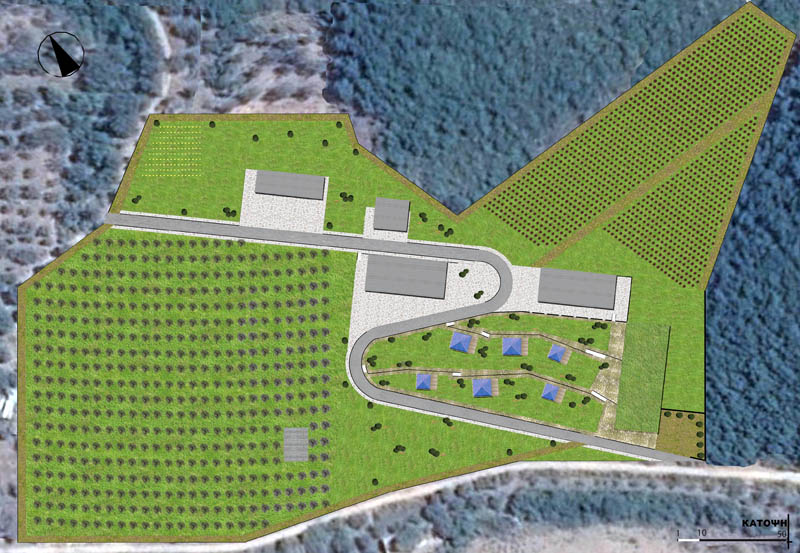



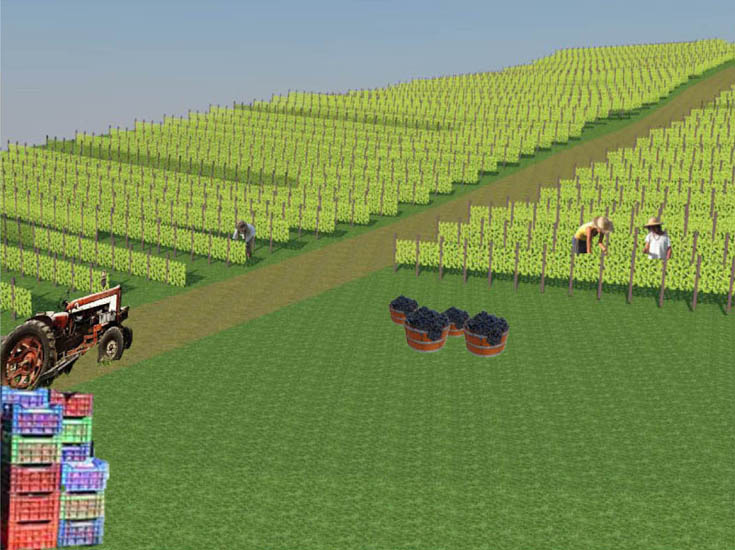

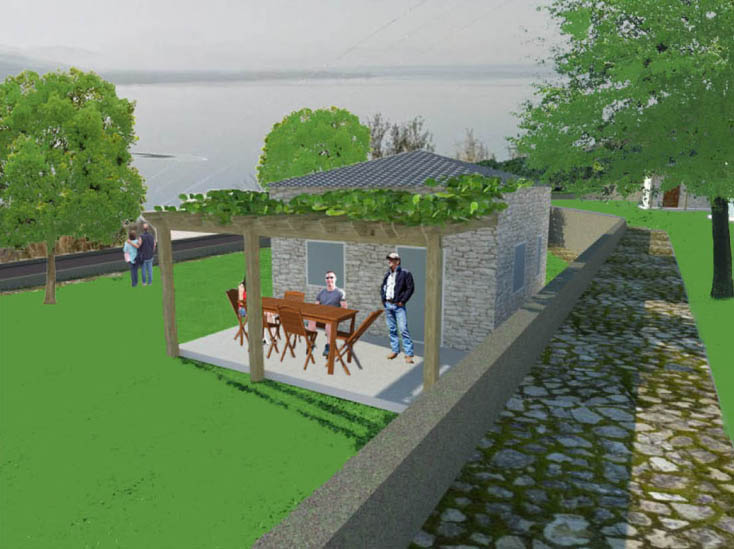



The growing attention of the alternative forms of tourism (ecotourism, food tourism, agro-rural tourism, cultural , social, educational, medical etc) is a fact. The visitor is now trying to combine leisure and relaxation ,by satisfying the need for unique experiences and by coming closer to an environment, free of any human intervention. Therefore, many regions with special characteristics are developing facilities, suitable for the alternative tourist, becoming in that way popular destinations.
This thesis is aiming at the creation of a modern agrotourism complex in the surrounding area of the lake Trichonida. The complex is located outside the the settlement of Sitralonon, which is 30 km away from Agrinion city. The plot is chosen because of the amphitheatrical position, the land suitability (suitable for the chosen cultivations) and its short distances from the city centers of Agrinion and Thermo. The proposal includes the construction of guest houses, laboratories for the elaboration of the products, market place, coffee shop, canteen and farms (grove, vine, honey). It is aiming at the participation of tourists in line production as well as the familiarization of modern ways and means of cultivation. A bond between nature and them is developing.
In conclusion, the complex can provide several advantages or the region: income, employment, use accommodation, activities, natural resource conservation, recreation and education. The tourist, apart form the fact that will get to participate in the production step by step, will also have the chance to visit and learn more about the surrounded areas. He can see at first hand how the history is connected with the land and the residents, how the lake is affected by all these and how important are the flora and fauna that have been developed around the lake.
Supervisor: Triantafillidis Giorgos
Reference Number: 513
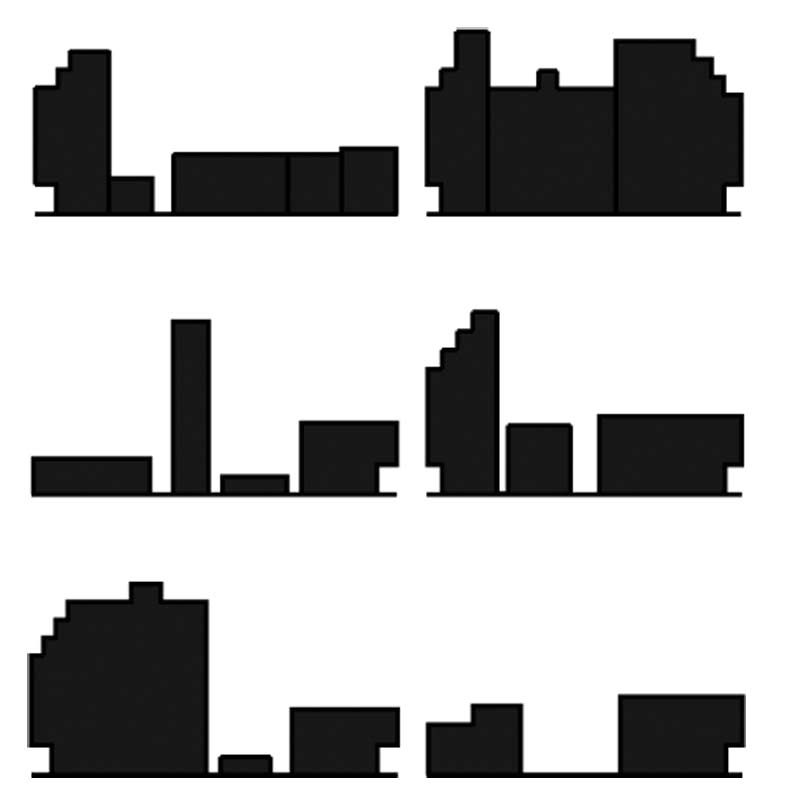

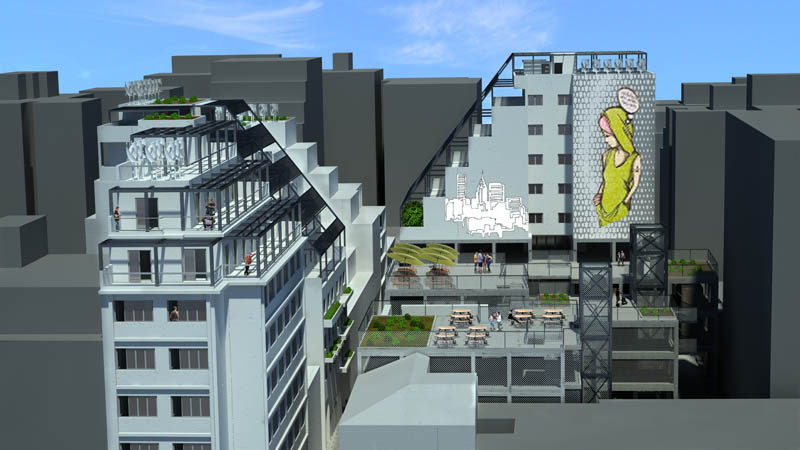





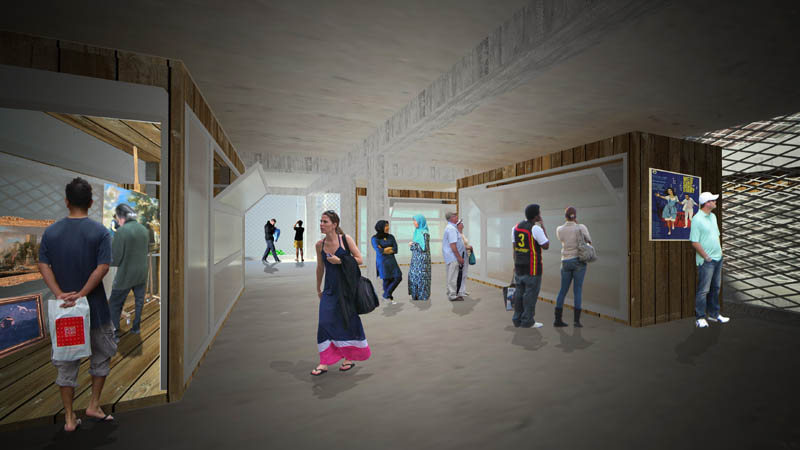



The Gerani area, just a few minutes away from Omonoia Square in Athens, accumulates a series of problems of economic and socio-political nature, dragging it into a deep degradation and marginalization in the recent years. As a result, the local population discredits it and has been keeping a distance. Buildings become ruins and succumb to the wear and tear with exponential growth, while delinquent behaviors thrive, taking advantage of the situation, making it even worse. The eponymous street in the heart of the area stands as the most notorious of them all, as the “ghetto” of Athens, the inaccessible street.
After identifying a series of advantages and possibilities that still exist despite the downgrade, we undertake the initiative of proposing a plan to revitalize the area, focusing on Geraniou Street. This plan articulates by proposing solutions to each distinct part of the bigger problem, starting with people as a criterion and as a motive. The people that we want to administer, reside and enjoy the city and its structures.
The key aspects of the proposition come to re-shape the form of ownership and administration in economic terms, the management of the building stock, the relationship between the man-made and the natural environment and especially the program of functions and how they get distributed throughout a system of contiguous structures. We aspire that a general plan of urban revitalization that acknowledges the city as an intricate network of relations and correlations can overturn the negative status quo and trigger the application of analogous organized manipulations on a wider scale.
Supervisors: Gavrilou Evelyn, Stylidis Iordanis
Reference Number: 518
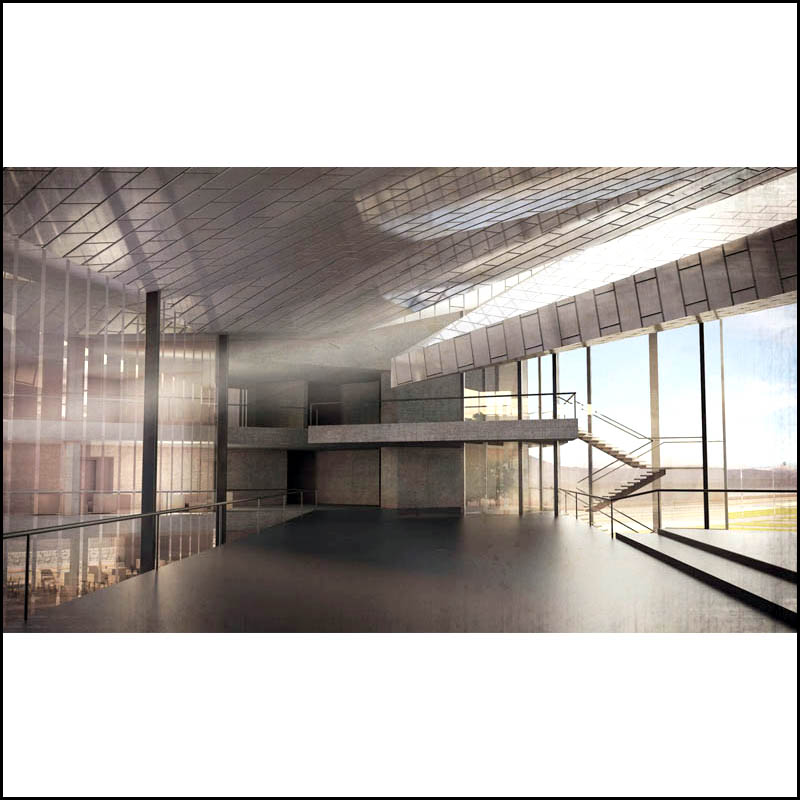



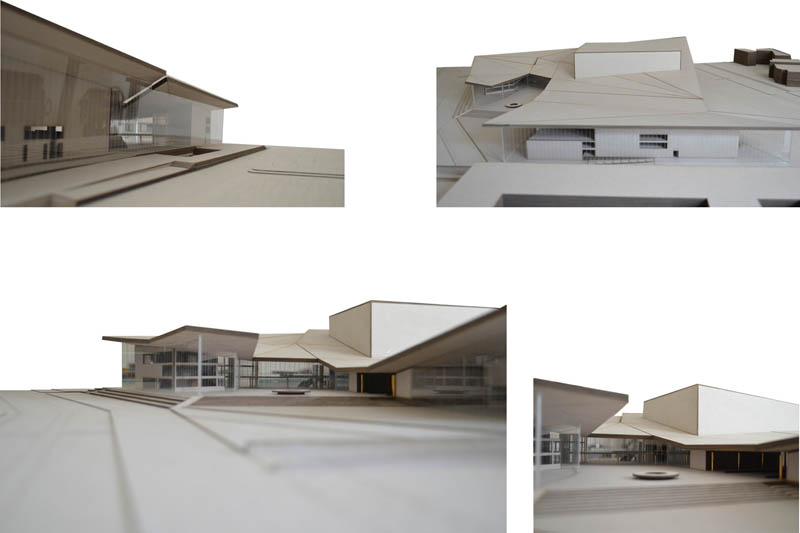

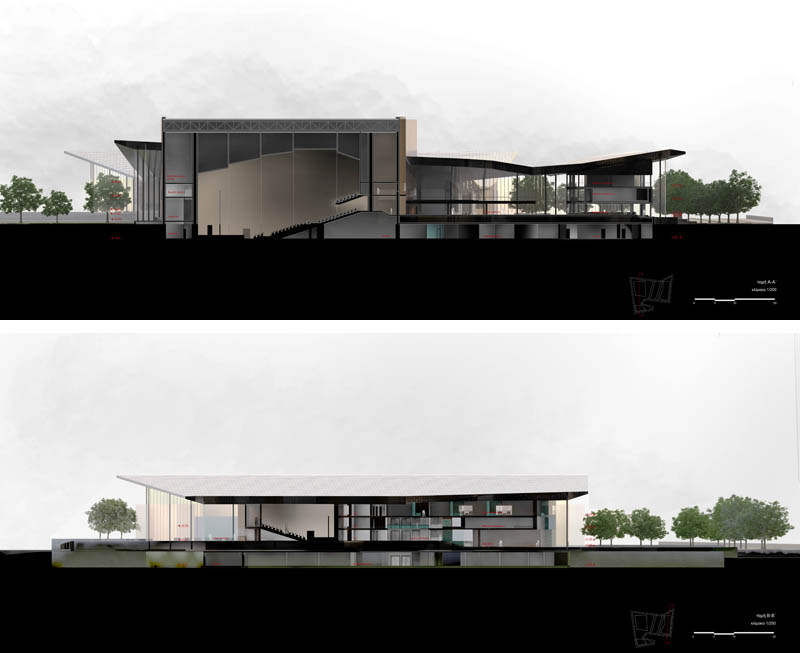

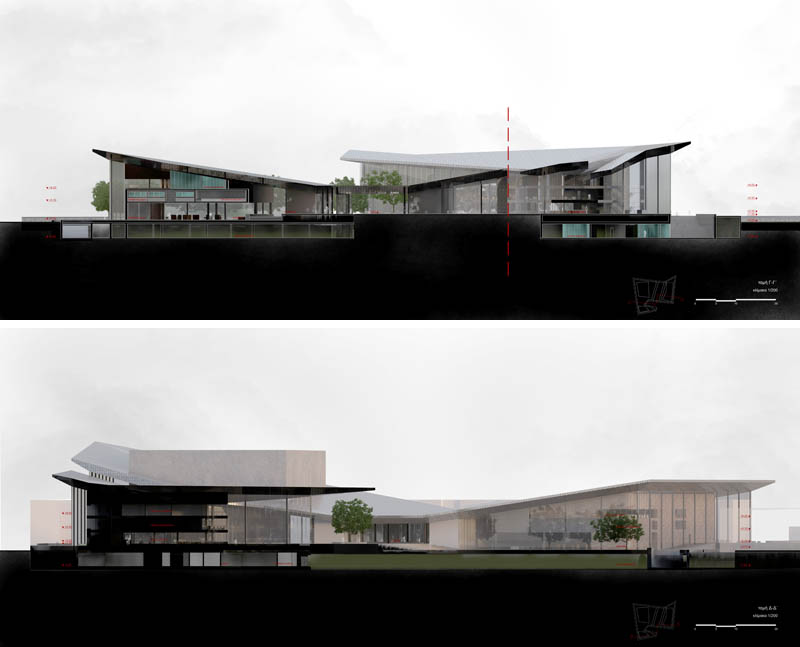



Subject of this study is to design a medium-size conference center (501-1200 participants), in the littoral of the city of Ioannina.
Ioannina, the capital of the prefecture, is a town with rich cultural and historical heritage, called herein to demonstrate its capabilities, aiming at sustainable development and creating a strong identity.
The emergence of Ioannina city by strengthening alternative forms of tourism, such as conference tourism is a parameter that the city would be beneficial to study and aim at, as the latter has significant growth potential.
Key design goals were to create a building landmark, the correlation of both the urban front of the south side and with the natural landscape of the north, the creation of green spaces open to the city.
The central element of the composition is the centerline, created as a continiuty of the existing urban fabric shaft and connects the two large squares as well as the creation of a shelter that houses and unifies both areas of the conference center, and the central route.
Thus, the possibility of autonomous operation sections of the conference center, contributed to the nucleation, created a type of building within the building, which received the uses of the building program with separating and unifying the common areas.
The building houses an auditorium, capacity of 1000 seats and a smaller of 250 seats, conference, meetings and seminars rooms, dining rooms, a small library, as well as underground parking.
As for the construction, two building systems are created, one of the cores of the building and one of the metal roof.
Supervisor: Triantafillidis Giorgos
Reference Number: 488
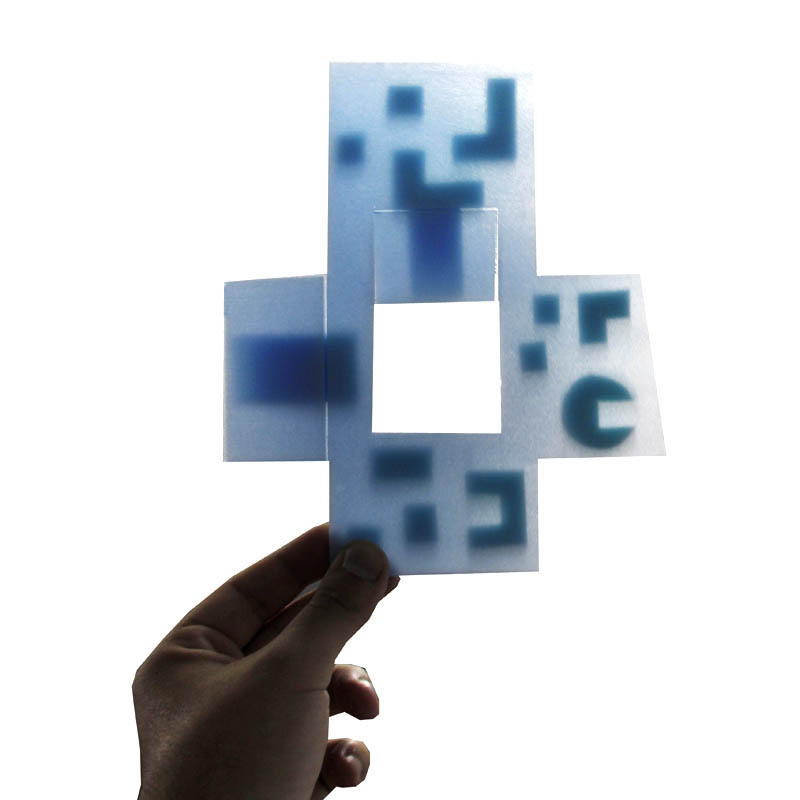

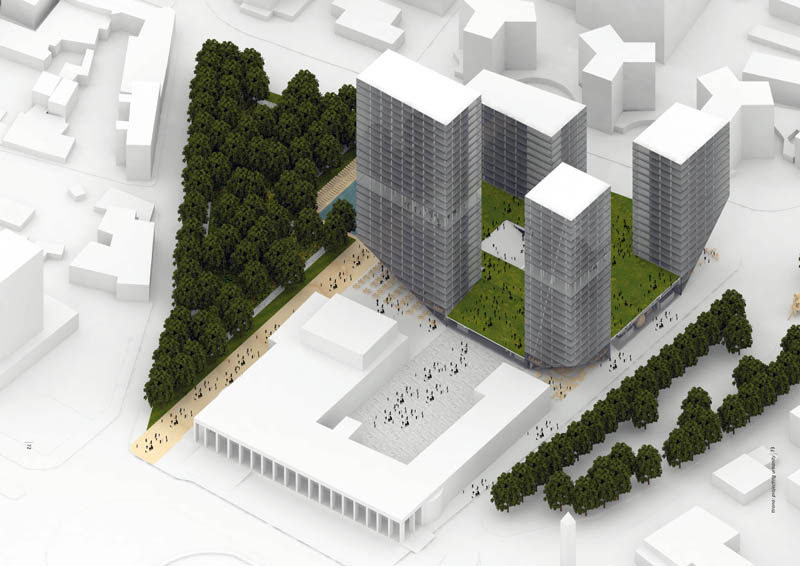



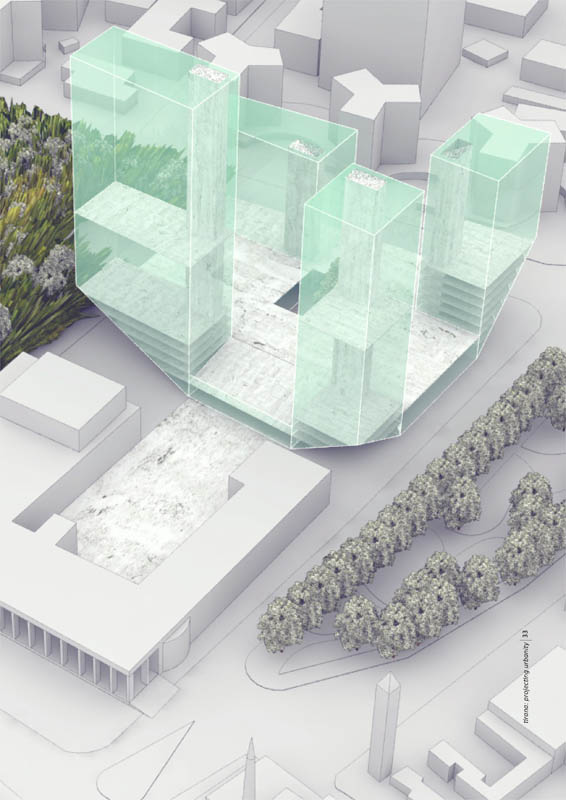



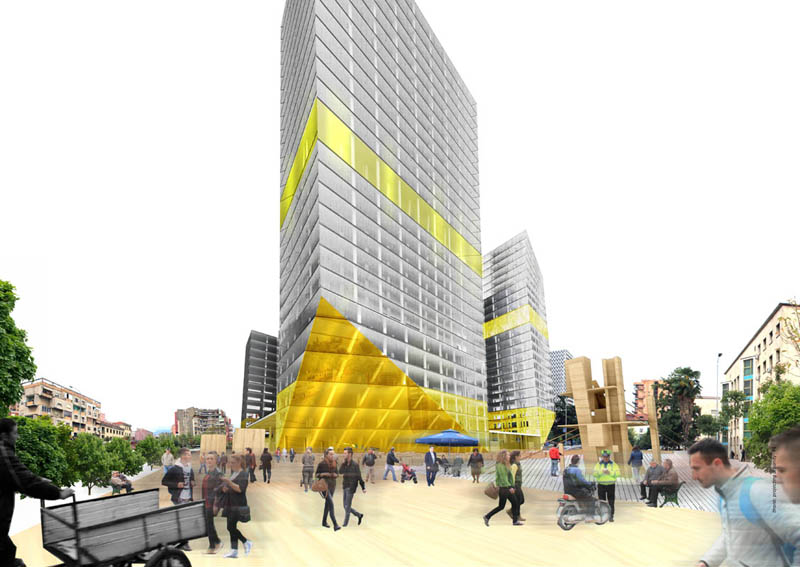

The topic of the diploma thesis project is the design of a complex of four tall buildings, which are interconnected on the ground floor. The project is placed on a 20.000 m² site in the center of Tirana, intervening in the inconvenient green park which exists so far behind the historical building of Tirana’s Opera. The aim of the intervention is the intensification of the use of the site and its integration into the urban realm of the city.
The central idea of the project may be summarized in the following phrase: "instead of a mediocre park, let’s have two intensified urban condensers, an ‘urban forest’ and a complex of buildings with a mixed program for the city". In this way, half of the plot is being constructed in its maximum volume permitted by the city’s regulations, and the other half of it receives denser vegetation and trees to become more useful and appealing to urban dwellers.
On the ground level, the project reproduces the (typological) micro scale and the program of the city itself on that particular area of the site. In this sense, the base of the buildings (the Plinth) serves as a roof which embraces and defines four fundamental categories of activities: market/trade, contemporary art/education, cultural activities/leisure and sports. Those four different programmatic subjects are interconnected and join the urban realm on their open side to the existing or the newly designed sidewalks. The edges of the buildings on the level of the street are well defined and fully transparent so that the continuity with the urban context is not interrupted.
On each of the four corners of the cross-shaped plinth, a building is raised which is of a particular size. The tallest of those four buildings (100 m) aspires to become Tirana’s new landmark. Let’s call those tall buildings ‘Towers’ (in Albanian ‘Kulla’), once according to the height standards of Tirana, such a tall construction is considered a Tower. Designing these four Towers the project becomes relevant to the recent tradition of Tirana to intensify its center by constructing tall buildings during the last fifteen years. The four towers have also a particular characteristic which makes them special: a big diagonal part of their lower part is missing and part of its vertical program is ‘contaminated’ with public activities, so they don’t serve only for dwelling/apartments and working/offices. The height of the diagonal cuts, as well as the overall heights of the tower, are following the heights of the neighbor buildings, so that the project get integrated into the scale of the context.
Following such design principles, the buildings which compose the project reveal their impressive presence of scale only above the skyline of the area, once under the skyline they "reflect urban void to the city’s constructed urban solid". On the urban voids created by the subtraction of the Towers’ lower part, open public spaces are being created on which various public activities can take place, or moreover, on which the interior public program of the Plinth can extend: continuity of interior program (building) towards the exterior spaces (city).
The open public spaces created on the bases of the towers are in ‘communication’ with additional elements, such as the ‘urban forest’ which serves as an extension of the sports program in the northern part of the Plinth, or the backyard of the Opera building which serves as a well-framed events space opposite to the cultural program part of the Plinth etc.
The whole project is also unified by a big linear boulevard which starts from Skenderberg Square and finishes at the Eastern side of the site.
Supervisor: Paniyiris Costis
Reference Number: 502
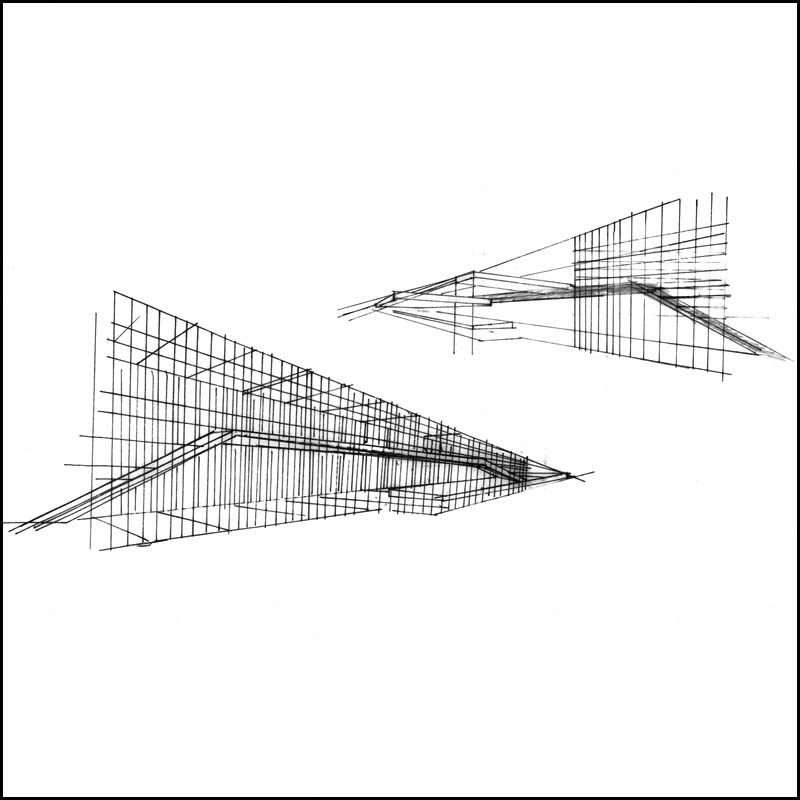



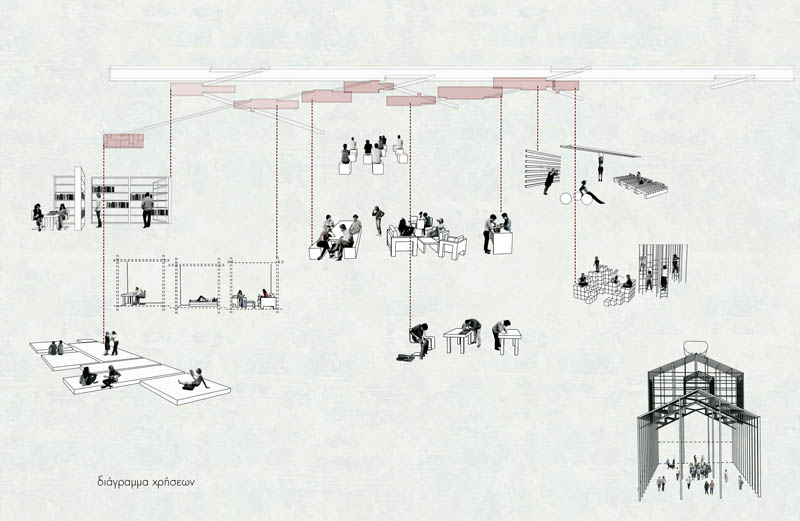



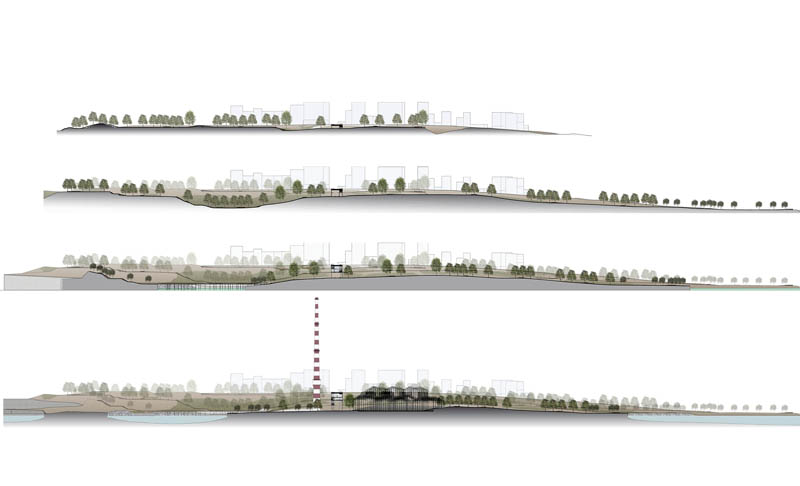

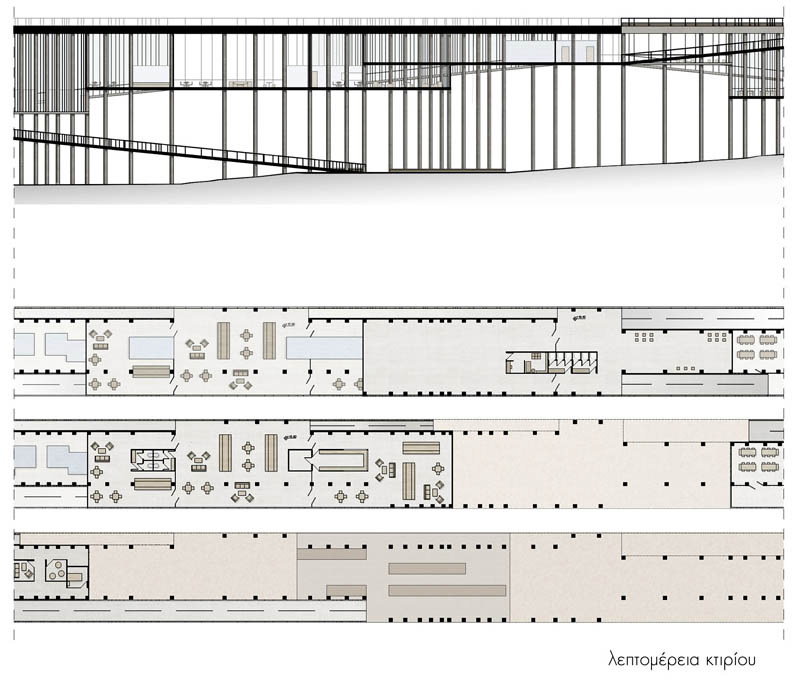

This thesis objective is based upon the potential access to the seafront of Drapetsona region through the creation of a metropolitan scale open public space in the location of the former industrial compound of Lipasmata.
The characteristic of being unreachable is persistent in the region for many years now, actually a wall exists, separating the town from seafront. The previous use marks are gradually fading out through time, while new use has not yet been realized despite the many proposals that have been filled. Furthermore the region is considered, by the local community, as a field of consistent reclaims, mostly because of its limitless potential to provide green space in an area characterized by dense urban construction, as developed in the 20th century.
We attempt to answer these questions by extending the road connecting Drapetsona region with the former fertilizer units. We are creating a pier that functions as a walking axis to the seafront, a new ground within and beyond the existing.This new ground serves as a discovering function of the existing, for the city itself as well as for the ground of Lipasmata.Reversing vertically the image of the town, we place activity layers, scheduled and relevant with free time under this axis. These layers function as buffers in the town’s exit to the Lipasmata ground, where we create four walking and green axis, crossing the area. We thus contribute to the ground reoccupying efforts, which the natural element seeks, aided by abandonment and two decades time since the demolition of the former factory establishments and we envision the prevalence of a metropolitan park.
We attend the existing ground as an infusion of rubble traces that are unable to establish the image of its former use. We attempt to answer the historical memory issue that stems from this fact, not by revival of abolition of the past, but rather with a dynamic historical record that communicates with the contemporary and keeps looking for new uses, keeping eyes open to the past.
Supervisors: Gavrilou Evelyn, Paniyiris Costis
Reference Number: 493
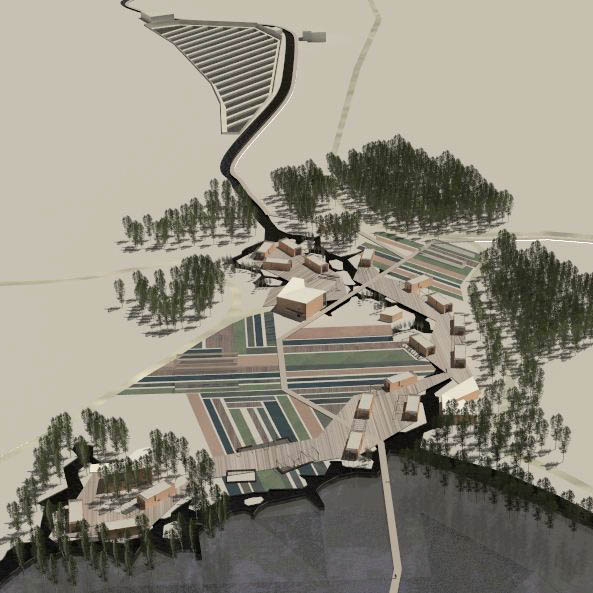

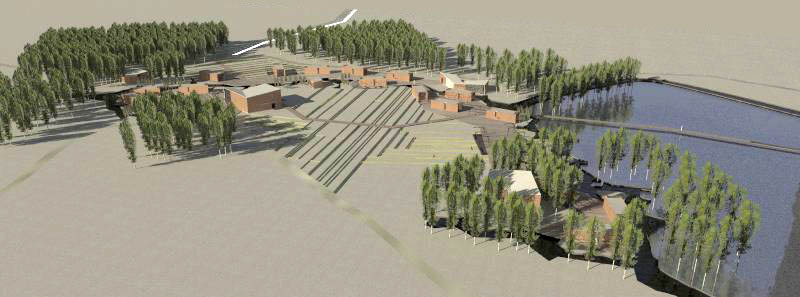



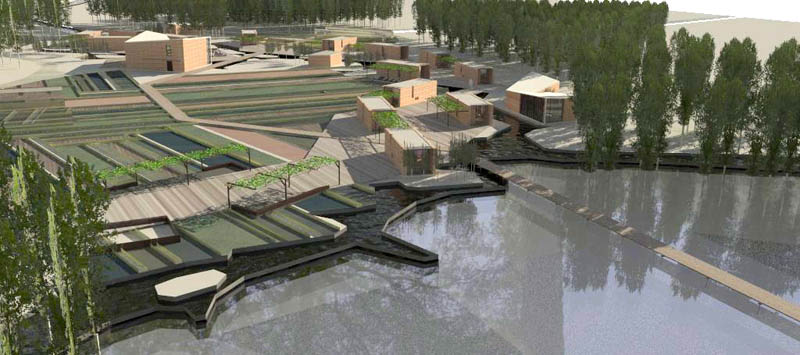

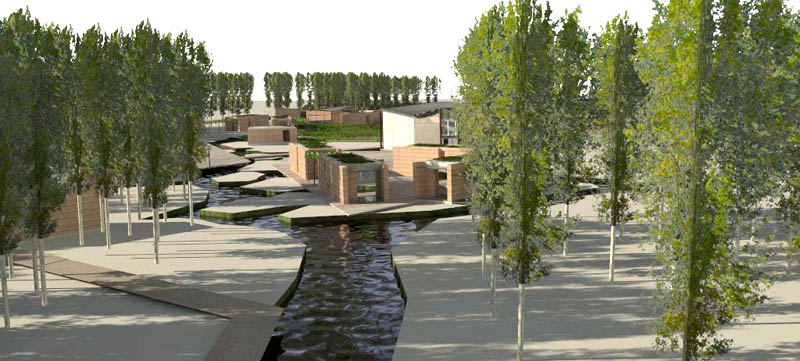



The diploma project has to do with the study and the planning of an agro-touristic “campus” containing 34 beds. It is located between the villages “Ano Kefalari” and “Kato Kefalari” of the prefecture of Drama. Aim of this project is the beginning of an agro-touristic development of the area. The natural intensity and the innumerable natural water sources are the remarkable phenomenon. The water that spouts creates rivers, contemporary lakes and a particular natural vegetation that diffuses in the above mentioned flows. The route of water influences the surrounding space that counts a lot of villages, thousands of acres and landmarks of the wider area.
These are: 1. The aquaculture between Ano Kefalari akd Kato Kefalari, 2. The square of Ano Kefalari, 3. The pine forest of Kirgia, 4. The park of predator birds in Agora, 5. The archeological site of Filippoi and the first baptistery of Europe at Lidia, 6. The “clay spa” of Krinides and 7. The European path 04. Their union will be a cycle road that will join all of these with the agro-touristic “campus”.
Main factor of the area choice is the big fish farm that functions there. The agro-tourists have the opportunity to occupy with and have experience on the primary production, in this case of fish. This production is a part of a closed system of cultivation where other crops participate (mushrooms, worms, duck weed, hydroponics).
The basic lines of the project come from the natural shapes of the surrounding environment and the random shapes and limits of water. That way we have formed seven layers: 1. The natural forest of the area, 2. The river flow, 3. The road net and the bicycle net, 4. The closed loop agricultural system, 5.The dack-base where leans our campus, 6. The tourist houses and 7. The public buildings.
Supervisor: Triantafillidis Giorgos
Reference Number: 500

